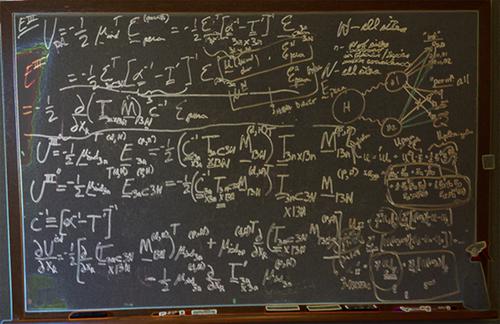当前位置:
X-MOL 学术
›
WIREs Comput. Mol. Sci.
›
论文详情
Our official English website, www.x-mol.net, welcomes your
feedback! (Note: you will need to create a separate account there.)
Advanced models for water simulations
Wiley Interdisciplinary Reviews: Computational Molecular Science ( IF 16.8 ) Pub Date : 2017-11-23 , DOI: 10.1002/wcms.1355 Omar Demerdash 1, 2 , Lee‐Ping Wang 3 , Teresa Head‐Gordon 1, 2, 4, 5
Wiley Interdisciplinary Reviews: Computational Molecular Science ( IF 16.8 ) Pub Date : 2017-11-23 , DOI: 10.1002/wcms.1355 Omar Demerdash 1, 2 , Lee‐Ping Wang 3 , Teresa Head‐Gordon 1, 2, 4, 5
Affiliation

|
Molecular simulations of water using classical, molecular mechanic potential energy functions have enjoyed a 50‐year history of development, and much has been learned regarding their parameterization and the essential physics that must be captured in order to reproduce water properties across the phase diagram and across system sizes, from the dimer to the condensed phase. While pairwise‐additive force fields using fixed, point charge‐based electrostatics have dominated this history owing to computational cost, their limitations in transferability are being recognized, owing particularly to the lack of many‐body effects, as well as an inherent difficulty in capturing quantum mechanical effects that become important at short intermolecular separation. This has spurred an impressive development of novel functional forms and parameterization schemes to account for such effects, especially the leading many‐body effect of polarization. This review discusses recent efforts in the development of advanced models of water, particularly with regard to important details of their parameterization from quantum mechanical or experimental data, the development of novel functional forms including machine learning‐based models, and algorithms that reduce the computational cost of polarization dramatically, permitting them to potentially become competitive with pairwise‐additive models as the standby of condensed‐phase simulation. These technical developments are appraised based on their ability to impact numerical calculations on water, particularly the condensed phase, and it is hoped that this article provides a clear connection between the essential physics captured by the model and their fitness across a range of environments. WIREs Comput Mol Sci 2018, 8:e1355. doi: 10.1002/wcms.1355
中文翻译:

用于水模拟的高级模型
使用经典的分子力学势能函数进行水的分子模拟已经有50年的发展历史,并且已经掌握了许多有关参数化和必须掌握的基本物理知识的知识,以便在相图中和整个表面上重现水的性质。系统尺寸,从二聚体到浓缩相。尽管由于计算成本,使用固定的,基于点电荷的静电对的成对加性力场在历史上占据了主导地位,但由于缺乏多体效应以及捕获固有的困难,人们认识到了它们在可传递性方面的局限性量子机械效应在短分子间分离中变得很重要。这刺激了令人印象深刻的新功能形式和参数化方案的发展,以解决此类影响,尤其是极化的主要多体效应。这篇综述讨论了高级水模型开发的最新成果,特别是有关从量子力学或实验数据进行参数化的重要细节,新型功能形式(包括基于机器学习的模型)的开发以及可降低计算成本的算法方面的讨论。极化能力的显着提高,使它们有可能成为成对相加模型的竞争者,成为凝聚相仿真的备用模型。评估这些技术进展的依据是它们对水(尤其是冷凝相)的数值计算产生影响的能力,WIRES Comput Mol Sci 2018,8:e1355。doi:10.1002 / wcms.1355
更新日期:2017-11-23
中文翻译:

用于水模拟的高级模型
使用经典的分子力学势能函数进行水的分子模拟已经有50年的发展历史,并且已经掌握了许多有关参数化和必须掌握的基本物理知识的知识,以便在相图中和整个表面上重现水的性质。系统尺寸,从二聚体到浓缩相。尽管由于计算成本,使用固定的,基于点电荷的静电对的成对加性力场在历史上占据了主导地位,但由于缺乏多体效应以及捕获固有的困难,人们认识到了它们在可传递性方面的局限性量子机械效应在短分子间分离中变得很重要。这刺激了令人印象深刻的新功能形式和参数化方案的发展,以解决此类影响,尤其是极化的主要多体效应。这篇综述讨论了高级水模型开发的最新成果,特别是有关从量子力学或实验数据进行参数化的重要细节,新型功能形式(包括基于机器学习的模型)的开发以及可降低计算成本的算法方面的讨论。极化能力的显着提高,使它们有可能成为成对相加模型的竞争者,成为凝聚相仿真的备用模型。评估这些技术进展的依据是它们对水(尤其是冷凝相)的数值计算产生影响的能力,WIRES Comput Mol Sci 2018,8:e1355。doi:10.1002 / wcms.1355











































 京公网安备 11010802027423号
京公网安备 11010802027423号